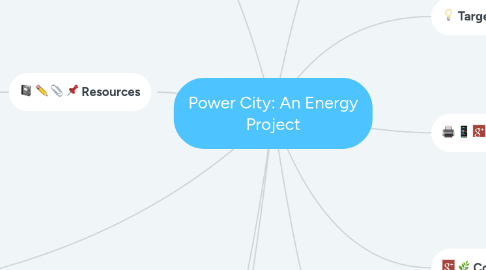Power City: An Energy Project
作者:Kristi Tripoli


1. Key Milestones
1.1. Prior to assignment
1.1.1. Assigned Chapter in textbook
1.1.2. Video Documentary Segments
1.1.3. Guest Speaker
1.2. Mini Goal 1 (2 days) Students will submit research (2/3 page typed) on their chosen energy source with a proper citation
1.3. Mini Goal 2 (2 days)Students will work on Presentation for Power City Reps. based on given guidelines.
1.4. Mini Goal 3: (1 in class day) Students will create an infographic on Canva
1.5. Day 6: "Tie up the Loose Ends" day: Practice for Presentation
2. Differentiation
2.1. IEP/Learning Plan guidelines carefully followed
2.2. Alternative Assignments given as deemed necessary
2.3. Balanced team work and individual work
2.4. Careful decision making when grouping students
2.5. Create small mini-goals for students to follow to get to the final product.
3. Resources
3.1. Notes from presentation from Solar Industry Representative Prior to assignment
3.2. Earth Science Textbook chapter on Renewable and Non-Renewable Resources
3.3. Small pieces of documentary on choosing energy sources
3.4. List of Websites students may utilize in their research
3.5. Printer
3.6. Lap top computers
3.7. Software:
3.7.1. Prezi
3.7.2. Canva
4. Evaluation/Assesmeent
4.1. Students will be grading according to a rubric for both the infographic and presentation. This rubric will be given to them when the project is assigned.
4.2. Self Assessment
4.2.1. Student will self-assess how well they worked with their group and the effort they placed into their final product on both the infographic and presentation.
5. Diocesan Standards: Allentown Diocese
5.1. Enduring Knowledge 8: Chemical imbalances are generated in Earth’s environment. .
5.1.1. Human impact on the environment can lead to chemical imbalances on our planet
5.1.2. Be familiar with air pollution
5.1.3. Be familiar with water pollution
6. Objectives
6.1. Students will be able to apply knowledge of renewable and nonrenewable energy sources to analyze their benefits and costs.
6.2. Students will be able to collaborate with one or two other students to develop an argument for one renewable and one non-renewable energy source for a fictional city with given parameters.
6.3. Students will be able to utilize a presentation tool such as Prezi or Google Slides to create a presentation on two energy sources.
6.4. Students will apply knowledge of renewable and nonrenewable energy sources to create an infographic in Canva that supports their argument for the benefits of one renewable or non-renewable energy source.
7. Target Audience
7.1. Middle School Students
7.2. Earth Science
7.3. 13-14 year old students
7.4. Differentiated Learners
8. Technology Incorporation
8.1. Canva (Infographic)
8.2. Google Classroom (Communication)
8.3. Prezi or Google Slides (Presentation)
9. Communication
9.1. Established Google Classrooms. Students are already familiar and in the practice of turning in assignments and working through Google Classroom. Items to be posted are:
9.1.1. Presentation Guidelines
9.1.2. Presentation Grading Rubric
9.1.3. Infographic Guidelines
9.1.4. Infographic Grading Rubric
9.1.5. Resources and Materials Students read or viewed in class
10. NGSS Standards
10.1. Analyzing and Interpreting Data: Analyzing data in 6–8 builds on K–5 and progresses to extending quantitative analysis to investigations, distinguishing between correlation and causation, and basic statistical techniques of data and error analysis.
10.1.1. Analyze and interpret data to determine similarities and differences in findings. (MS-ESS3-2)

